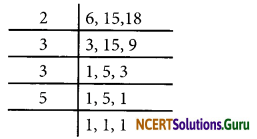NCERT Solutions for Class 6 Maths Chapter 3 Playing With Numbers InText Questions
These NCERT Solutions for Class 6 Maths Chapter 3 Playing With Numbers InText Questions and Answers are prepared by our highly skilled subject experts.
NCERT Solutions for Class 6 Maths Chapter 3 Playing With Numbers InText Questions
NCERT In-text Question Page No. 48
Question 1.
Find the possible factors of 45, 30 and 36.
Answer:
The possible factor of
45 = 1,3,5,9,15,45
30 = 1,2,3,5,6,10,15,30
36 = 1,2,3,4,6,9,12,18,36
![]()
NCERT In-text Question Page No. 52
Question 1.
Observe that 2 × 3 + 1 = 7 is a prime number. Here, 1 has been added to a multiple of 2 to get a prime number. Can you find some more numbers of this type?
Answer:
We can have:
2 × 2 + 1 = 5, which is a prime number.
2 × 5 + 1 = 11, which is a prime number.
2 × 6 + 1 = 13, which is a prime number.
2 × 8 + 1 = 17, which is a prime number.
2 × 9 + 1 = 19, which is a prime number.
2 × 11 + 1 = 23, which is a prime number.
NCERT In-text Question Page No. 58
Question 1.
Find the common factors of
(a) 8,20
(b) 9,15
Answre:
(a) 8, 20
Since, 8 = 1 × 8
8 = 2 × 4
∴ All the factors of 20 are: 1, 2, 4 and 8 …(i)
Again, 20 = 1 × 20
20 = 2 × 10
20 = 4 × 5
∴ All the factors of 20 are: 1, 2, 4, 5, 10 and 20 …(ii)
From (i) and (ii), common factors of 8 and 20 are: 1, 2 and 4.
![]()
(b) 9,15
We have: 9 = 1 × 9
9 = 3 × 3
∴ All the factors of 9 are: 1, 3 and 9 …(i)
Again, 15 = 1 × 15
15 = 3 × 5
∴ All the factors of 15 are: 1, 3, 5 and 15 …(ii)
From (i) and (ii), common factors of 9 and 15 are: 1 and 3.
NCERT In-text Question Page No. 61
Question 1.
Write the prime factorisations of 16, 28, 38.
Answer:
(i) 16
We have:

∴ Prime factorisation of 16 = 2 × 2 × 2 × 2
(ii) 28
We have:

∴ Prime factorisation of 28 = 2 × 2 × 7
![]()
(iii) 38
We have:

∴ Prime factorisation of 38 = 2 × 19
NCERT In-text Question Page No. 63
Question 1.
Find the HCF of the following:
(i) 24 and 36
(ii) 15, 25 and 30
(iii) 8 and 12
(iv) 12,16 and 28
Answer:
(i) 24 and 36
∵ Factors of 24 are: 1, 2, 3, 4, 6, 12 and 24
Factors of 36 are: 1, 2, 3, 4, 6, 12, 18 and 36
∵ Common factors are: 1, 2, 3, 4, 6 and 12
Since, the highest of these common factors = 12
∴ HCF of 24 and 36 = 12
(ii) 15, 25 and 30
∵ Factors of 15 are: 1, 3, 5 and 15
Factors of 25 are: 1, 5 and 25
Factors of 30 are: 1, 2, 3, 5, 6, 10, 15 and 30
∴ Common factors are: 1 and 5
Since, the highest common factors is 5,
HCF of 15, 25 and 30 = 5
(iii) 8 and 12
∵ Factors of 8 are: 1, 2, 4 and 8
Factors of 12 are: 1, 2, 3, 4, 6 and 12
∴ Common factors are: 1, 2, 4
Since, the highest common factors is 4,
∴ HCF of 8 and 12 = 4
![]()
(iv) 12,16 and 28
∵ Factors of 12 are: 1, 2, 3, 4, 6 and 12
Factors of 16 are: 1, 2, 4, 8 and 16
Factors of 28 are: 1, 2, 4, 7, 14 and 28
∴ Common factors are: 1, 2, 4
Since, the highest common factors is 4,
∴ HCF of 12, 16 and 28 = 4
NCERT Solutions for Class 6 Maths Chapter 3 Playing With Numbers InText Questions Read More »



















































